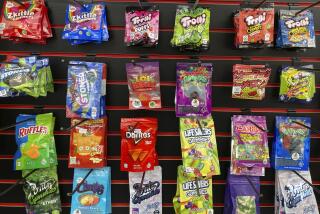Low-Emission Biodiesel Is Gaining Mainstream Attention
Surrounded by a pack of tail-wagging dogs, Dave Hawley of Ukiah stuck his bearded face up to the exhaust pipe of his delivery truck, closed his eyes and inhaled.
Hawley is hooked on biodiesel, a low-emission fuel gleaned from restaurant grease or the oil of crops such as soybeans.
Biodiesel is the fastest-growing alternative fuel in the country, according to the National Biodiesel Board, which touts its ability to extend engine life, improve fuel economy, cut down on air pollution and reduce reliance on foreign oil.
It has been in use in Europe for some 15 years.
But biodiesel is more expensive than traditional diesel -- at least 30% more at one point last summer.
To lower costs, lawmakers have proposed tax incentives for using biodiesel, but Congress adjourned for the session without acting on the bills.
âIf it were the same price, I think we would see use expand dramatically,â said Jenna Higgins, spokeswoman for the biodiesel board, a trade group affiliated with the U.S. Department of Agriculture.
Biodiesel releases less carbon monoxide and fewer hydrocarbons and particles than petroleum-based diesel, according to the Environmental Protection Agency. It works with most diesel engines.
Hawleyâs so sold on it, heâs even sipped the amber-colored liquid to demonstrate its low toxicity to the 100-plus customers of his Yokayo Biofuels firm in Ukiah, Calif. Customers include farmers, California wineries and a fleet of coffee delivery trucks.
âIt really just gives people a way not to live with hypocrisy,â Hawley said outside the garage where he and business partner Kumar Plocher experiment with batches of lye, wood or grain alcohol and various vegetable oils.
Biodiesel is produced by blending lye, methanol or ethanol and oil, then letting it settle. Glycerin, a soap ingredient, separates from biodiesel in large vats.
Plocher and Hawley might even add essential oils so tailpipes will spew the scent of lavender, rosemary or sage.
Yokayo distributes 13,000 gallons of biodiesel a month -- enough to rank as one of the countryâs largest independent distributors in this small but growing industry, which now has annual sales of about $25 million, according to the National Biodiesel Board.
Tim Piper, director of vineyard operations for Fetzer Vineyards, one of Californiaâs 10 largest wineries, has powered tractors and other farm equipment with biodiesel for the last year.
âTheyâre running great, absolutely no difference,â Piper said.
Except for the price.
In its most common form, biodiesel is sold in a mixture of 80% petroleum-based diesel and 20% biodiesel.
Because of growing demand and relatively few suppliers, a gallon of the 80-20 blend cost $1.79 on the West Coast in July, compared with $1.38 for a gallon of petrodiesel, according to the Department of Energy. Pure biodiesel costs even more.
But many conservationists say they donât mind paying more for cleaner fuel, and federal pollution regulations also are providing an incentive for managers of fleets. The U.S. Postal Service, for instance, has used biodiesel at several locations, including San Francisco, Miami and New York.
Higgins said biodiesel has grown quickly in use because it generally works with any diesel engine made after 1992. She said older engines need only slight modifications -- many have parts made with natural rubber, which could interact adversely with biodiesel.
Other fuel alternatives, such as natural gas and propane, need special equipment or more extensive modifications.
Though biodiesel, like one form of traditional diesel, has a tendency to coagulate at colder temperatures, producers and distributors can add anti-jell substances to prevent that.
Dieselâs roots are organic. Rudolph Diesel, the German engineer whose engine concept published in 1893 eventually bore his name, fueled his prototype with peanut oil. But such oils lost sway when petroleum-based fuel became cheaper and more plentiful.
Biodiesel producers are hoping for an organic comeback.
U.S. production of biodiesel is expected to grow to more than 20 million gallons this year and as much as 40 million gallons in 2003, according to the biodiesel board. Soybean oil accounted for 90% of the material used to produce biodiesel in 2001.
Hawley and Plocher say theyâre already turning a modest profit and plan to open biodiesel filling stations in Ukiah and Santa Rosa, Calif., in the next few months, complete with a convenience store stocked with organic products.
They also hope to persuade other biodiesel peddlers to open in other parts of California to encourage more use.
âThe beauty of biodiesel, in my opinion, is it comes from plants,â Plocher said. âItâs part of an active cycle.â
More to Read
Inside the business of entertainment
The Wide Shot brings you news, analysis and insights on everything from streaming wars to production â and what it all means for the future.
You may occasionally receive promotional content from the Los Angeles Times.










